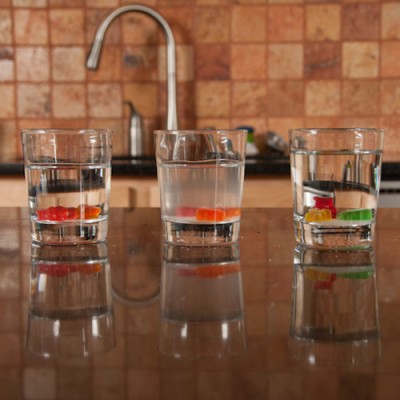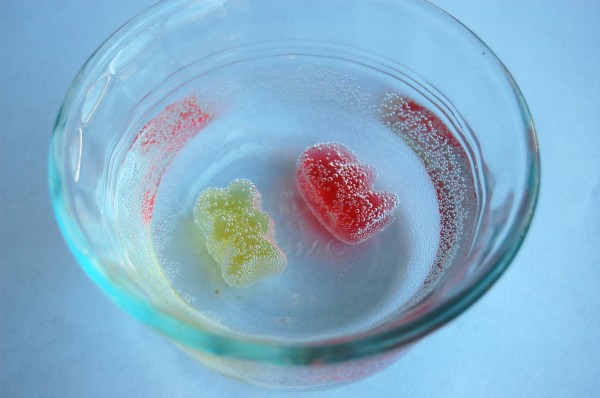Gummy Bear Lab Report
Hypothesis: What do you think will happen to a gummy bear when you put it in water overnight?
I think the gummy bear will absorb the water causing the gummy bear to increase.
Measurements:
The length of your gummy bear should be measured from the top of its head to the bottom of its feet to the nearest tenth of a centimeter.
1.) Measure the width at the widest point across the back of the bear to the nearest tenth of a centimeter.
2.) Measure the thickness from the front to the back at the thickest point to the nearest tenth of a centimeter.
3.) Calculate the volume by multiplying the length, width, and thickness. Round to the nearest hundredth.
4.) Measure the mass using a triple-beam balance or other scale to the nearest tenth of a gram.
5.) Calculate the density by dividing the mass by the volume. Round answer to the nearest hundredth.
Procedure: Part A
Choose one gummy bear from the container on your table. Use the equipment available to measure your gummy bear and record the data in the chart for Day 1.
Experiment Data:
Day: 1
Bear Color: Green
Length: 2 cm
Width: 1 cm
Thickness: 1 cm
Volume: 2 cm3
Mass: 2.2 g
Density: 1.1 g/cm3
Volume Change: 50 mL
Procedure: Part B
Put the bear in a cup labeled with your name and class period. Add 50 ml of water to the cup and allow it to sit overnight. On Day 2, remove the gummy bear from the cup of water and use a towel to dry it off to prevent it from dripping all over the place. Repeat the measurements from Part A and record your data in the correct portion of the chart. Determine the amount of change for each measurement and record in the chart.
Experiment Data:
Day: 2
Bear Color: Green
Length: 4 cm
Width: 2 cm
Thickness: 2 cm
Volume: 16 cm3
Mass: 8.7 g
Density: .54 g/cm3
Procedure: Part C
Put the water bear in a cup labeled with your name and class period. Add 50 ml of salt water to the cup and allow it to sit overnight. On Day 3, remove the gummy bear from the cup of water and use a towel to dry it off to prevent it from dripping all over the place. Repeat the measurements from Part B and record your data in the correct portion of the chart. Determine the amount of change for each measurement and record in the chart.
Experiment Data:
Day: 3 (Salt Water)
Bear Color: Yellowish / White
Length: 3.4 cm
Width: 2 cm
Thickness: 1.5 cm
Volume: 10.20 cm3
Mass: 5.9 g
Density: .59 g/cm3
Volume Change: 1 mL
Post Lab Questions:
1. Yes my hypothesis was correct. My hypothesis was correct because the gummy bear got larger as it sits in the water each night.
2. The volume change is bigger because the measurements changed.
3. Yes, there is a change in density because the gummy bear has a huge difference between the mass and volume.
4. My results compared to my classmates results is different. Not every one of our measurements is accurate. For example the measurements of my length, width, thickness, volume, mass, etc is different from my classmates. In addition the color of the gummy bear are different as well.
6. Looking specifically at the volume, the longer the gummy bear is left in water the more it will increase. For instance on day 1 the volume of the bear was 2 cm3; however, on day 2 the volume is 16 cm3.
7. I would change this lab to test another variable by adding a different liquid. For example vinegar, milk, baking soda, etc.
8.The biological process that occurs in this lab is osmosis and diffusion. In this process water in entering the gummy bear to balance everything out in the water, which causes the gummy bear to increase.


